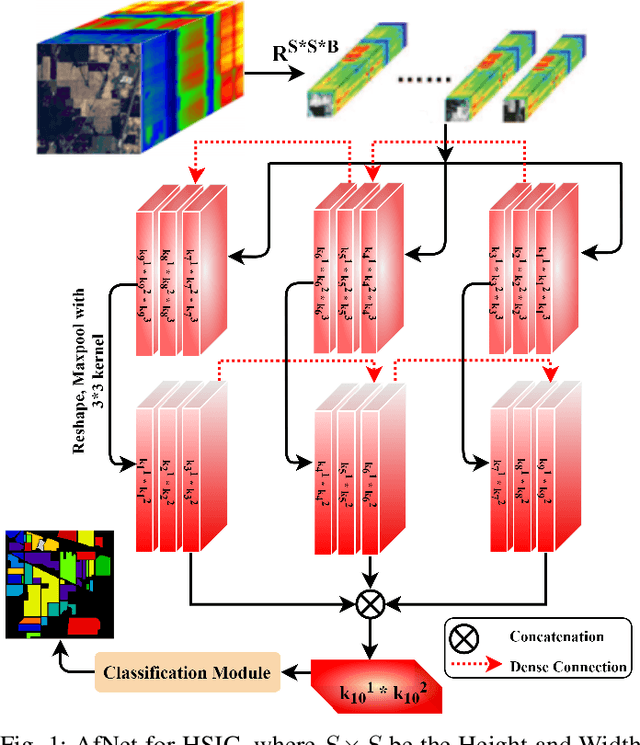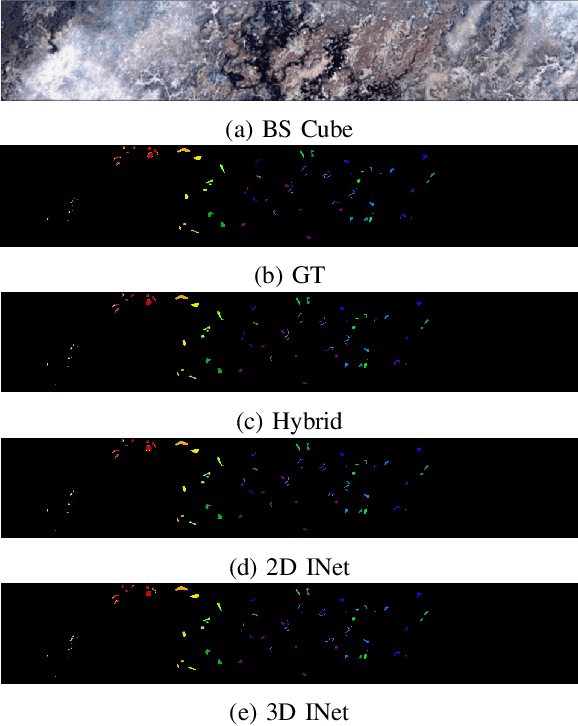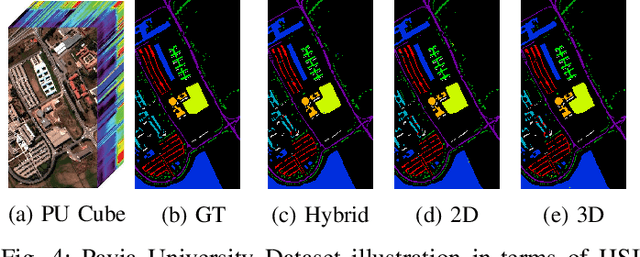Adil Mehmood Khan
Dynamic Memory-enhanced Transformer for Hyperspectral Image Classification
Apr 17, 2025Abstract:Hyperspectral image (HSI) classification remains a challenging task due to the intricate spatial-spectral correlations. Existing transformer models excel in capturing long-range dependencies but often suffer from information redundancy and attention inefficiencies, limiting their ability to model fine-grained relationships crucial for HSI classification. To overcome these limitations, this work proposes MemFormer, a lightweight and memory-enhanced transformer. MemFormer introduces a memory-enhanced multi-head attention mechanism that iteratively refines a dynamic memory module, enhancing feature extraction while reducing redundancy across layers. Additionally, a dynamic memory enrichment strategy progressively captures complex spatial and spectral dependencies, leading to more expressive feature representations. To further improve structural consistency, we incorporate a spatial-spectral positional encoding (SSPE) tailored for HSI data, ensuring continuity without the computational burden of convolution-based approaches. Extensive experiments on benchmark datasets demonstrate that MemFormer achieves superior classification accuracy, outperforming state-of-the-art methods.
Hybrid State-Space and GRU-based Graph Tokenization Mamba for Hyperspectral Image Classification
Feb 10, 2025



Abstract:Hyperspectral image (HSI) classification plays a pivotal role in domains such as environmental monitoring, agriculture, and urban planning. However, it faces significant challenges due to the high-dimensional nature of the data and the complex spectral-spatial relationships inherent in HSI. Traditional methods, including conventional machine learning and convolutional neural networks (CNNs), often struggle to effectively capture these intricate spectral-spatial features and global contextual information. Transformer-based models, while powerful in capturing long-range dependencies, often demand substantial computational resources, posing challenges in scenarios where labeled datasets are limited, as is commonly seen in HSI applications. To overcome these challenges, this work proposes GraphMamba, a hybrid model that combines spectral-spatial token generation, graph-based token prioritization, and cross-attention mechanisms. The model introduces a novel hybridization of state-space modeling and Gated Recurrent Units (GRU), capturing both linear and nonlinear spatial-spectral dynamics. GraphMamba enhances the ability to model complex spatial-spectral relationships while maintaining scalability and computational efficiency across diverse HSI datasets. Through comprehensive experiments, we demonstrate that GraphMamba outperforms existing state-of-the-art models, offering a scalable and robust solution for complex HSI classification tasks.
DiffFormer: a Differential Spatial-Spectral Transformer for Hyperspectral Image Classification
Dec 23, 2024



Abstract:Hyperspectral image classification (HSIC) has gained significant attention because of its potential in analyzing high-dimensional data with rich spectral and spatial information. In this work, we propose the Differential Spatial-Spectral Transformer (DiffFormer), a novel framework designed to address the inherent challenges of HSIC, such as spectral redundancy and spatial discontinuity. The DiffFormer leverages a Differential Multi-Head Self-Attention (DMHSA) mechanism, which enhances local feature discrimination by introducing differential attention to accentuate subtle variations across neighboring spectral-spatial patches. The architecture integrates Spectral-Spatial Tokenization through three-dimensional (3D) convolution-based patch embeddings, positional encoding, and a stack of transformer layers equipped with the SWiGLU activation function for efficient feature extraction (SwiGLU is a variant of the Gated Linear Unit (GLU) activation function). A token-based classification head further ensures robust representation learning, enabling precise labeling of hyperspectral pixels. Extensive experiments on benchmark hyperspectral datasets demonstrate the superiority of DiffFormer in terms of classification accuracy, computational efficiency, and generalizability, compared to existing state-of-the-art (SOTA) methods. In addition, this work provides a detailed analysis of computational complexity, showcasing the scalability of the model for large-scale remote sensing applications. The source code will be made available at \url{https://github.com/mahmad000/DiffFormer} after the first round of revision.
Spatial-Spectral Morphological Mamba for Hyperspectral Image Classification
Aug 02, 2024Abstract:In recent years, Transformers have garnered significant attention for Hyperspectral Image Classification (HSIC) due to their self-attention mechanism, which provides strong classification performance. However, these models face major challenges in computational efficiency, as their complexity increases quadratically with the sequence length. The Mamba architecture, leveraging a State Space Model, offers a more efficient alternative to Transformers. This paper introduces the Spatial-Spectral Morphological Mamba (MorpMamba) model. In the MorpMamba model, a token generation module first converts the Hyperspectral Image (HSI) patch into spatial-spectral tokens. These tokens are then processed by a morphology block, which computes structural and shape information using depthwise separable convolutional operations. The extracted information is enhanced in a feature enhancement module that adjusts the spatial and spectral tokens based on the center region of the HSI sample, allowing for effective information fusion within each block. Subsequently, the tokens are refined in a multi-head self-attention block to further improve the feature space. Finally, the combined information is fed into the state space block for classification and the creation of the ground truth map. Experiments on widely used Hyperspectral (HS) datasets demonstrate that the MorpMamba model outperforms (parametric efficiency) both CNN and Transformer models.
A Comprehensive Survey for Hyperspectral Image Classification: The Evolution from Conventional to Transformers
May 09, 2024



Abstract:Hyperspectral Image Classification (HSC) is a challenging task due to the high dimensionality and complex nature of Hyperspectral (HS) data. Traditional Machine Learning approaches while effective, face challenges in real-world data due to varying optimal feature sets, subjectivity in human-driven design, biases, and limitations. Traditional approaches encounter the curse of dimensionality, struggle with feature selection and extraction, lack spatial information consideration, exhibit limited robustness to noise, face scalability issues, and may not adapt well to complex data distributions. In recent years, Deep Learning (DL) techniques have emerged as powerful tools for addressing these challenges. This survey provides a comprehensive overview of the current trends and future prospects in HSC, focusing on the advancements from DL models to the emerging use of Transformers. We review the key concepts, methodologies, and state-of-the-art approaches in DL for HSC. We explore the potential of Transformer-based models in HSC, outlining their benefits and challenges. We also delve into emerging trends in HSC, as well as thorough discussions on Explainable AI and Interoperability concepts along with Diffusion Models (image denoising, feature extraction, and image fusion). Lastly, we address several open challenges and research questions pertinent to HSC. Comprehensive experimental results have been undertaken using three HS datasets to verify the efficacy of various conventional DL models and Transformers. Finally, we outline future research directions and potential applications that can further enhance the accuracy and efficiency of HSC. The Source code is available at \href{https://github.com/mahmad00/Conventional-to-Transformer-for-Hyperspectral-Image-Classification-Survey-2024}{github.com/mahmad00}.
Traditional to Transformers: A Survey on Current Trends and Future Prospects for Hyperspectral Image Classification
Apr 23, 2024



Abstract:Hyperspectral image classification is a challenging task due to the high dimensionality and complex nature of hyperspectral data. In recent years, deep learning techniques have emerged as powerful tools for addressing these challenges. This survey provides a comprehensive overview of the current trends and future prospects in hyperspectral image classification, focusing on the advancements from deep learning models to the emerging use of transformers. We review the key concepts, methodologies, and state-of-the-art approaches in deep learning for hyperspectral image classification. Additionally, we discuss the potential of transformer-based models in this field and highlight the advantages and challenges associated with these approaches. Comprehensive experimental results have been undertaken using three Hyperspectral datasets to verify the efficacy of various conventional deep-learning models and Transformers. Finally, we outline future research directions and potential applications that can further enhance the accuracy and efficiency of hyperspectral image classification. The Source code is available at https://github.com/mahmad00/Conventional-to-Transformer-for-Hyperspectral-Image-Classification-Survey-2024.
Low Rank Properties for Estimating Microphones Start Time and Sources Emission Time
Jul 22, 2023Abstract:Uncertainty in timing information pertaining to the start time of microphone recordings and sources' emission time pose significant challenges in various applications, such as joint microphones and sources localization. Traditional optimization methods, which directly estimate this unknown timing information (UTIm), often fall short compared to approaches exploiting the low-rank property (LRP). LRP encompasses an additional low-rank structure, facilitating a linear constraint on UTIm to help formulate related low-rank structure information. This method allows us to attain globally optimal solutions for UTIm, given proper initialization. However, the initialization process often involves randomness, leading to suboptimal, local minimum values. This paper presents a novel, combined low-rank approximation (CLRA) method designed to mitigate the effects of this random initialization. We introduce three new LRP variants, underpinned by mathematical proof, which allow the UTIm to draw on a richer pool of low-rank structural information. Utilizing this augmented low-rank structural information from both LRP and the proposed variants, we formulate four linear constraints on the UTIm. Employing the proposed CLRA algorithm, we derive global optimal solutions for the UTIm via these four linear constraints.Experimental results highlight the superior performance of our method over existing state-of-the-art approaches, measured in terms of both the recovery number and reduced estimation errors of UTIm.
Are Microphone Signals Alone Sufficient for Joint Microphones and Sources Localization?
May 19, 2023Abstract:Joint microphones and sources localization can be achieved by using both time of arrival (TOA) and time difference of arrival (TDOA) measurements, even in scenarios where both microphones and sources are asynchronous due to unknown emission time of human voices or sources and unknown recording start time of independent microphones. However, TOA measurements require both microphone signals and the waveform of source signals while TDOA measurements can be obtained using microphone signals alone. In this letter, we explore the sufficiency of using only microphone signals for joint microphones and sources localization by presenting two mapping functions for both TOA and TDOA formulas. Our proposed mapping functions demonstrate that the transformations of TOA and TDOA formulas can be the same, indicating that microphone signals alone are sufficient for joint microphones and sources localization without knowledge of the waveform of source signals. We have validated our proposed mapping functions through both mathematical proof and experimental results.
Justices for Information Bottleneck Theory
May 19, 2023
Abstract:This study comes as a timely response to mounting criticism of the information bottleneck (IB) theory, injecting fresh perspectives to rectify misconceptions and reaffirm its validity. Firstly, we introduce an auxiliary function to reinterpret the maximal coding rate reduction method as a special yet local optimal case of IB theory. Through this auxiliary function, we clarify the paradox of decreasing mutual information during the application of ReLU activation in deep learning (DL) networks. Secondly, we challenge the doubts about IB theory's applicability by demonstrating its capacity to explain the absence of a compression phase with linear activation functions in hidden layers, when viewed through the lens of the auxiliary function. Lastly, by taking a novel theoretical stance, we provide a new way to interpret the inner organizations of DL networks by using IB theory, aligning them with recent experimental evidence. Thus, this paper serves as an act of justice for IB theory, potentially reinvigorating its standing and application in DL and other fields such as communications and biomedical research.
Attention Mechanism Meets with Hybrid Dense Network for Hyperspectral Image Classification
Jan 04, 2022



Abstract:Convolutional Neural Networks (CNN) are more suitable, indeed. However, fixed kernel sizes make traditional CNN too specific, neither flexible nor conducive to feature learning, thus impacting on the classification accuracy. The convolution of different kernel size networks may overcome this problem by capturing more discriminating and relevant information. In light of this, the proposed solution aims at combining the core idea of 3D and 2D Inception net with the Attention mechanism to boost the HSIC CNN performance in a hybrid scenario. The resulting \textit{attention-fused hybrid network} (AfNet) is based on three attention-fused parallel hybrid sub-nets with different kernels in each block repeatedly using high-level features to enhance the final ground-truth maps. In short, AfNet is able to selectively filter out the discriminative features critical for classification. Several tests on HSI datasets provided competitive results for AfNet compared to state-of-the-art models. The proposed pipeline achieved, indeed, an overall accuracy of 97\% for the Indian Pines, 100\% for Botswana, 99\% for Pavia University, Pavia Center, and Salinas datasets.
 Add to Chrome
Add to Chrome Add to Firefox
Add to Firefox Add to Edge
Add to Edge